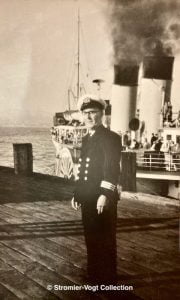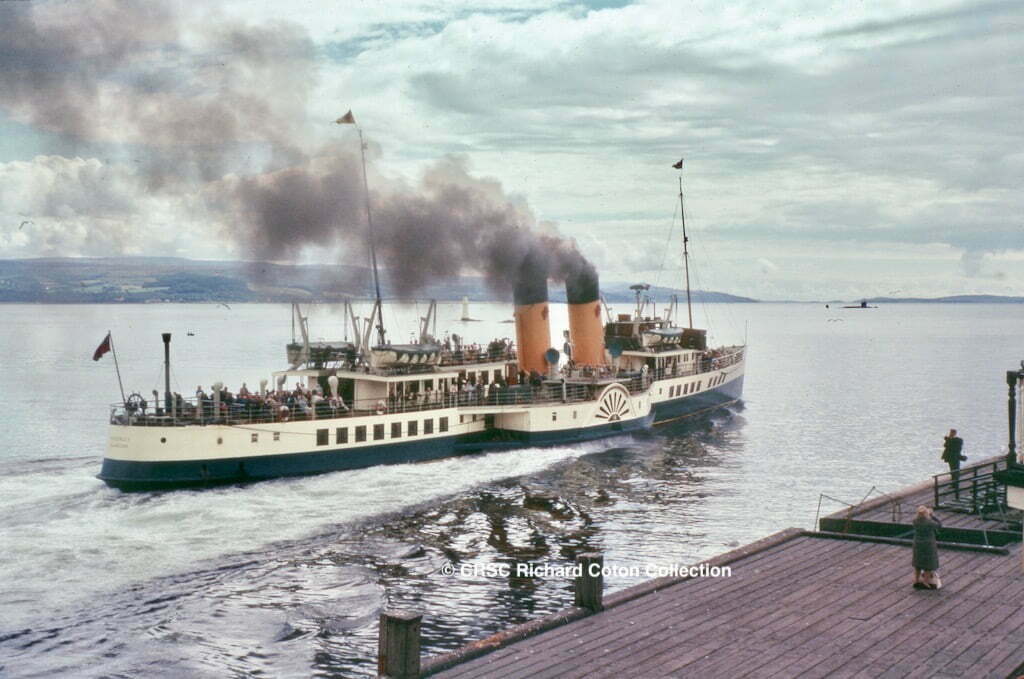Iain MacLeod gives a warm welcome to Eric Armstrong’s memoir of working on Waverley in the late 1960s, a ‘time of change in our history’ before foreign holidays and car ferries changed the Clyde scene for ever.
 In 1987, paddle steamer Waverley celebrated her 40th birthday and one of the projects which helped mark the occasion was the publication of a book. Birth of a Legend is a remarkable history of the paddler as she took shape in Inglis’ shipyard all those years earlier, a history brought to life by a unique set of photographs offered for the project by Eric Armstrong.
In 1987, paddle steamer Waverley celebrated her 40th birthday and one of the projects which helped mark the occasion was the publication of a book. Birth of a Legend is a remarkable history of the paddler as she took shape in Inglis’ shipyard all those years earlier, a history brought to life by a unique set of photographs offered for the project by Eric Armstrong.
Now, 35 years later and in time for an even more significant birthday, Eric has produced for Waverley Excursions Ltd another book, one which opens a different and still fascinating window into Waverley’s past when, astonishingly, the steamer which this year marks her 75th birthday was just 20 years old.
It is a book which had its origins on the bridge of PS Caledonia one day in May 1967, when that very special steamer was working a charter to and from Glasgow. Eric was invited up to the bridge, where he fell into conversation with Captain Donald Crawford, ‘a kindly man’ who asked him if he would be interested in a summer job on the steamers. ‘Yes,’ was Eric’s answer, and the result was the first of two seasons as deck boy aboard Waverley.
Those weeks aboard come brightly alive in an account whose main focus is really the people with whom Eric found himself, and what life was like living and working amongst them. This is not the book for you if you are looking for a review of 1967: as Eric himself writes, it is an evocation of ‘a simpler, slower and happier time’, a ‘time of change in our history’ before foreign holidays and car ferries changed the Clyde scene for ever.
Many people reading this review will find themselves whisked back by Eric’s book to a time when they, too, were young. That is certainly true for me. The handsome front cover photograph was taken by Tony Bennett as Waverley approached Dunoon pier after her cruise Round Bute on a Friday evening in late August 1967. I wonder if the young man talking to the assistant purser on the landing platform is not Eric himself. Although I had been on board Waverley for the Three Lochs Tour the previous day, on that Friday I had been up to Glasgow on Caledonia. For some reason I returned by train to Gourock in time to squeeze in trips on three more boats that early evening. All this means that I saw Waverley myself about 10 minutes after Tony took the picture, as she crossed to Gourock and I was sailing on Maid of Cumbrae back to Dunoon.
Why mention this? Simply to make the point that, as a passenger, I knew about Waverley in 1967. What I didn’t know, and what this book reveals for us all, is what happened aboard both before and after passengers joined her each day, what happened out of sight in the spaces forbidden to passengers. It was a different world.
Yes, it’s a book about people: we learn about their cramped surroundings; their day-to-day duties (in particular, of course, those of the deck boy but also, for example, the night man); their drinks (sometimes of tea); their meals; their backgrounds. It’s about human stories: an emergency dash to Gourock with an injured barman; a stewardess overboard; a Cowal Games piper toppling down the gangway. It’s about red letter days during the summer, like Cowal Games (Dunoon piermaster Beattie to the fore, but no mention of Traffic Manager Baker at Gourock with his megaphone) and Millport Illuminations, and about the end of season routine. It’s about details: confirmation for me of half-remembered bits of knowledge that the helmsman’s mark between Rothesay and Largs was ‘the wee white house on the hill’, and that chips weren’t served on CSP steamers.
It’s also about the rest of the fleet: how steering Caledonia was quite different from steering Waverley; how the master of Duchess of Hamilton, Fergus Murdoch, ‘had an abundance of knowledge and tales of the Clyde’ – and ‘a quirky sense of humour’ that seems not far beneath the surface in the photograph of him in the turbine’s wheelhouse. There are lots of photographs, some reproducing better than others, but all awakening memories and catching the atmosphere of those days long ago.
If you do remember the Clyde in the late 1960s, this is a book for you, for it will strike familiar chords for you and remind you of when we were all younger. If you don’t remember the Clyde in the late sixties, this is still a book for you, for it will give you an authentic flavour of what things were like during the last days of that unique set-up, with paddlers, turbines, passenger motor ships and car ferries criss-crossing the Firth day after day, each with their own quirks and personalities.
Life Aboard Waverley is a box of delights. If you buy a copy you will go on a wonderful journey back in time: but you will also help the Waverley of 2022. Every penny raised through sales of Eric’s memories and reflections will help to ensure that the steamer we remember from 1967 and enjoy in her 75th year sails successfully on towards her 100th birthday.
And, by the way, for those who missed Birth of a Legend in 1987, I’m told that it will be re-published later in the year.
Life Aboard Waverley (50 pages, softback) is published by Waverley Excursions and can be purchased from the WEL website for £11.95 inclusive of p&p — click here.
Published on 29 April 2022













